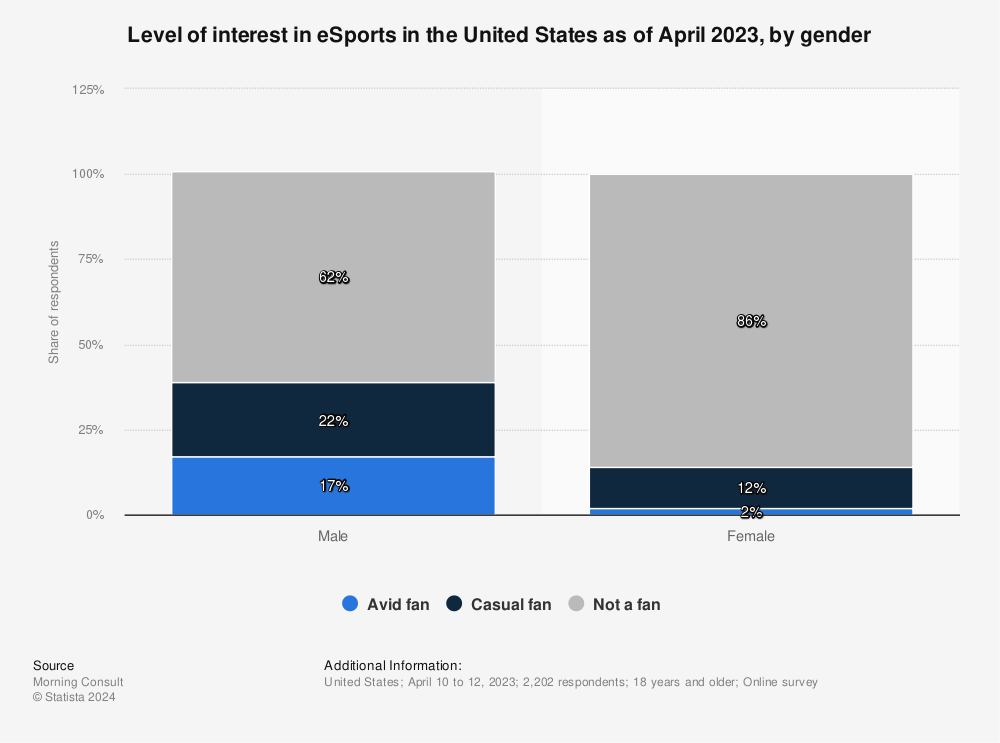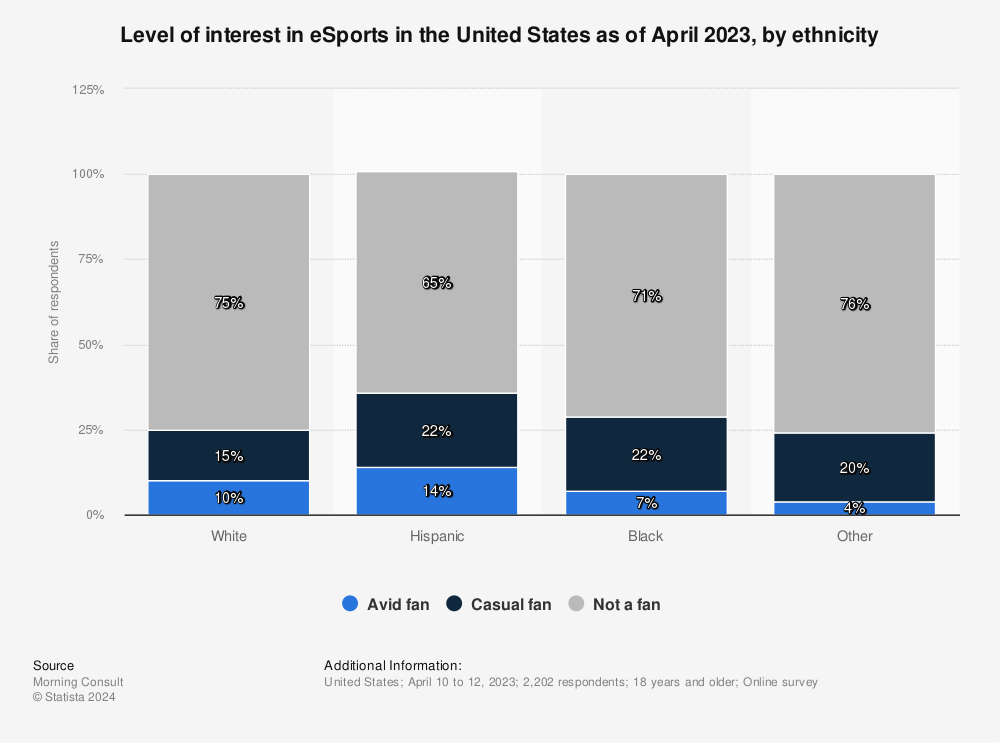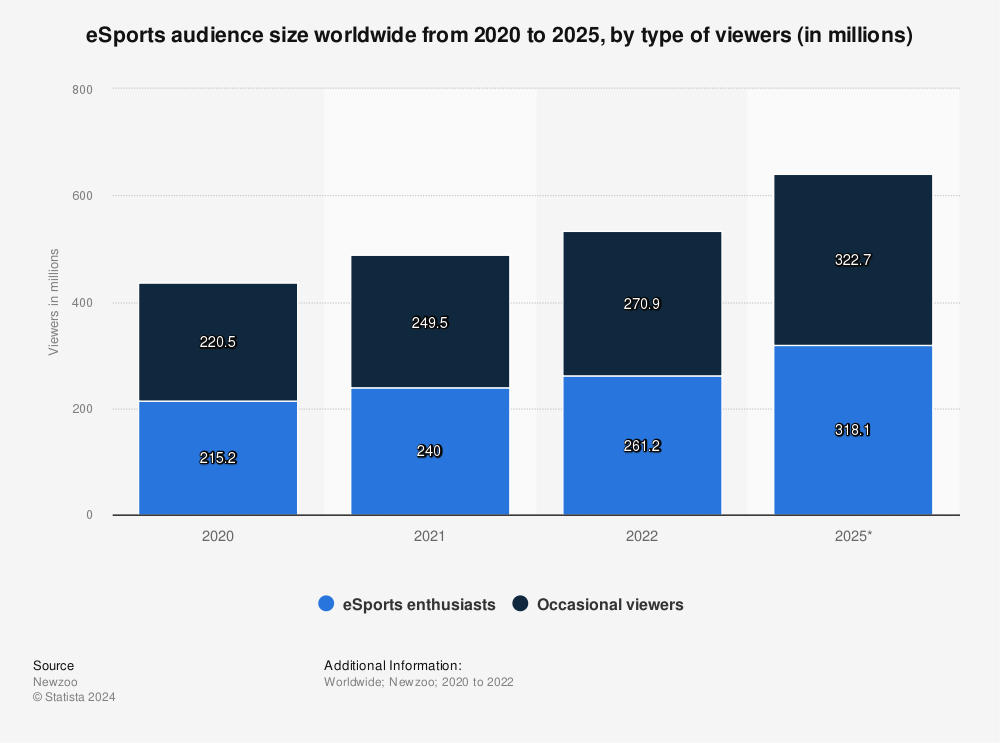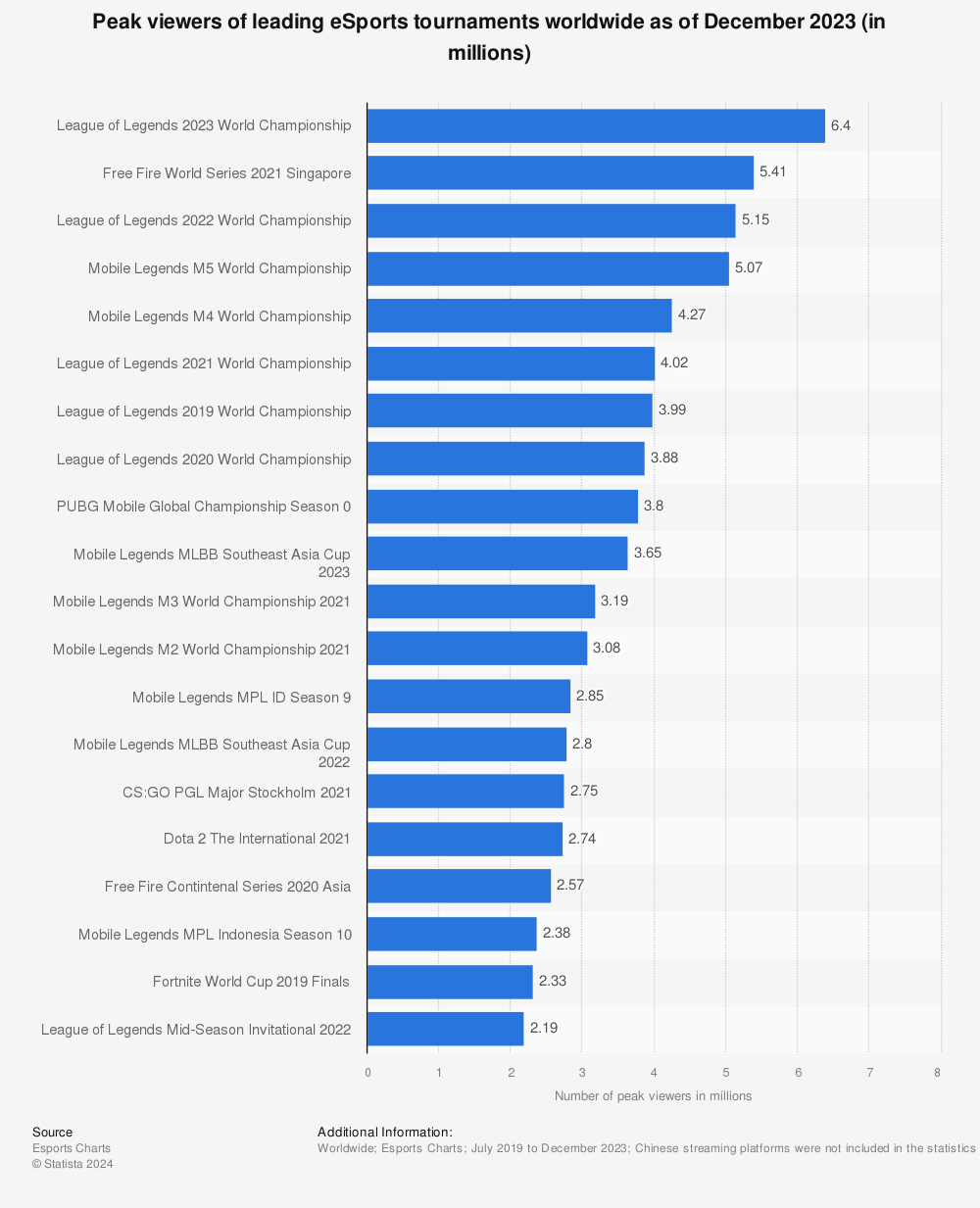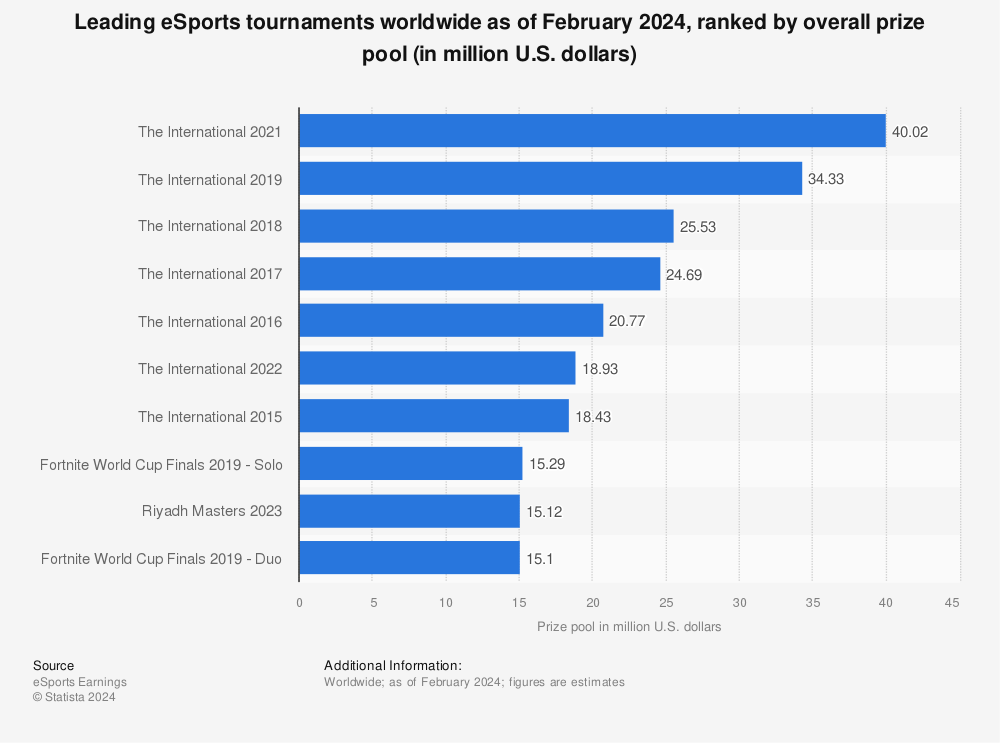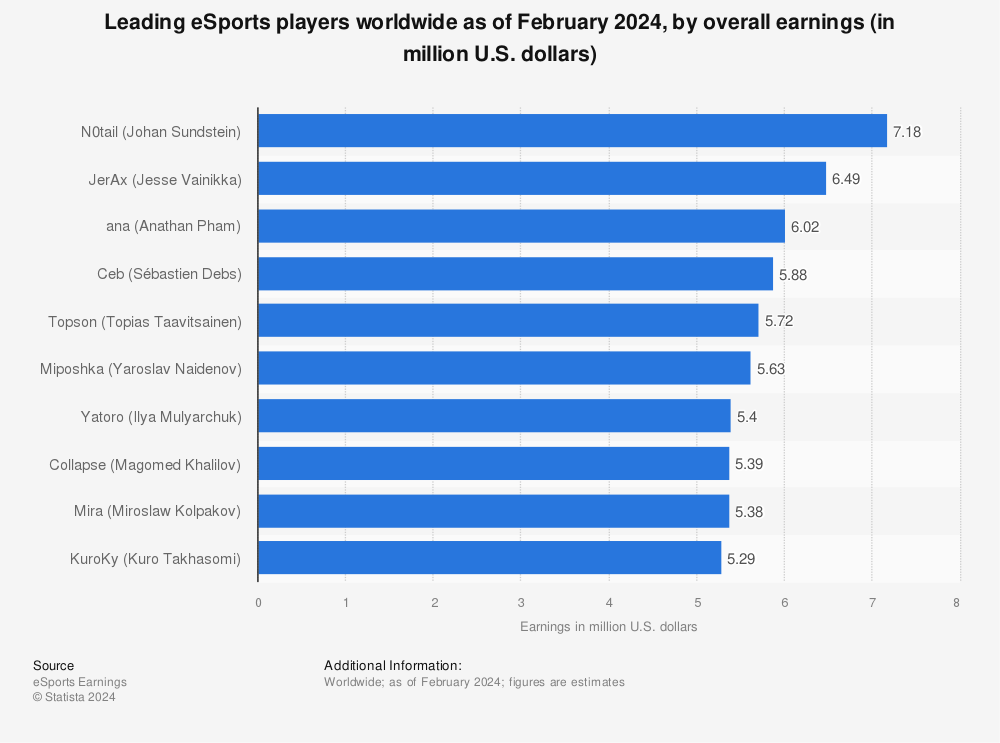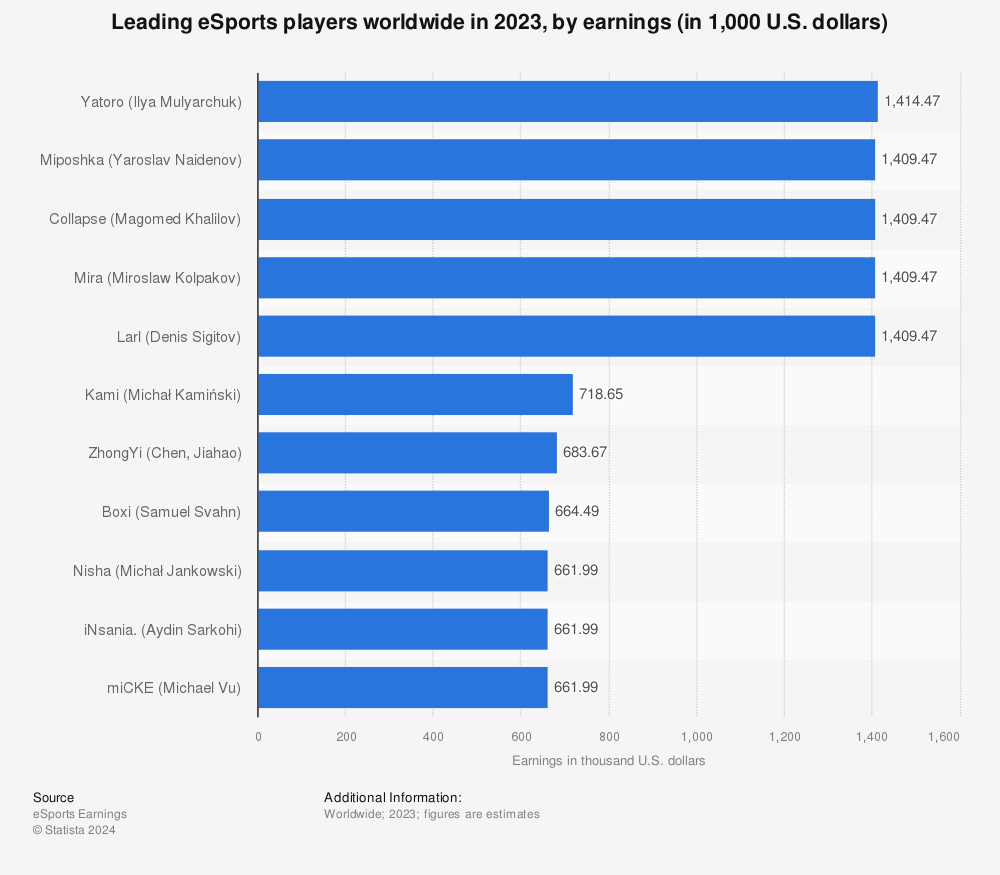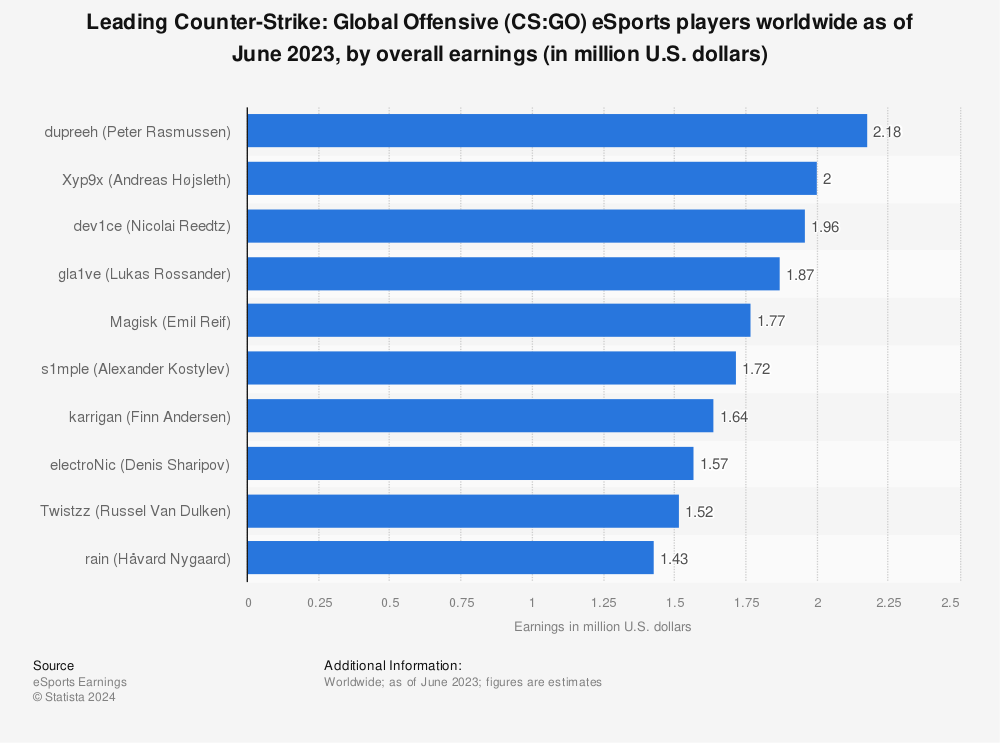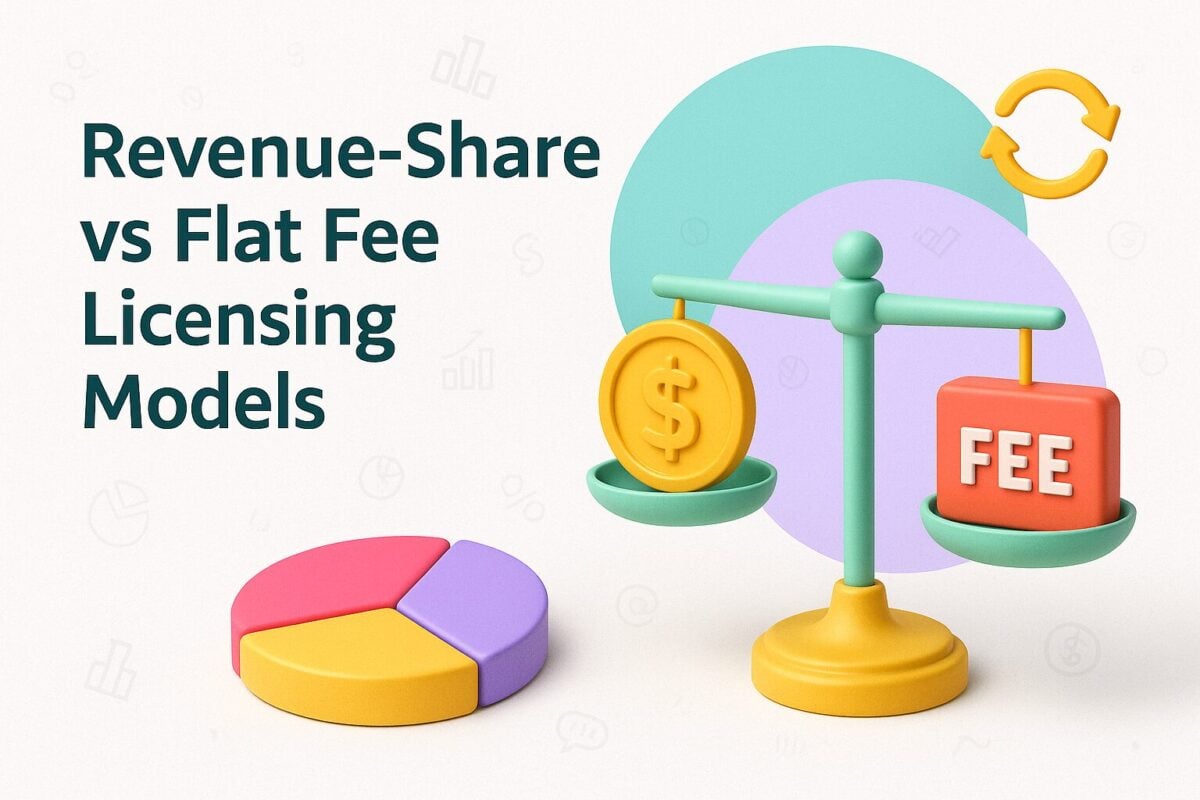The eSports industry has seen tremendous growth over the years, both in terms of viewership and revenue. The increasing viewership is what mainly contributed to the revenue growth. Seeing the potential of reaching a large and engaged audience, brands are investing in eSports marketing, more prominently, in eSports influencer marketing, both directly and indirectly.
For more insight into the current state of the eSports market, check out these 30+ recent statistics. From audience demographics to trending games, you can use this data to inform your strategies accordingly.
Most Relevant Esports Statistics (Editor’s Picks)
- Interest in eSports in the United States is the highest among younger audiences with 43% between the ages of 18 and 34 describing themselves as avid or casual fans. (Statista)
- The global eSports market is anticipated to be valued at $2.4 billion in 2024. (Statista)
- It’s predicted that by 2030 the market’s value will exceed $4.8 billion. (Statista)
- The League of Legends 2023 World Championship (aka LoL Worlds 2023) is the most watched eSports event to date, attracting 6.4 million peak viewers. (Statista)
- Multiplayer online battle arena games (aka MOBA games) are the most popular eSports game genre among Chinese fans. (Statista)
- N0Tail (aka Johan Sundstein) is regarded as the leading eSports player across the world in terms of overall earnings. (Statista)
- In 2023, 66% of all the eSports content was watched via an official channel. (Stream Hatchet)
Esports Demographics Statistics
1. 80% of eSports Fans Come From the APAC Region
A survey completed between May 2022 and April 2023 has revealed that the majority of eSports fans reside in the Asia-Pacific (APAC) region. A massive 80% of fans stay in one of the countries located here, with about 20% of respondents residing in China.
2. About 20% of US Citizens in Their 20s and 30s Are Serious Fans
A survey measuring public interest in eSports in the United States that was conducted in April 2023 has found that interest in eSports is the highest among participants between the ages of 18 and 34. One out of five (20%) described themselves as avid fans, while about a quarter (23%) were casual fans.
Interest levels are slightly lower among participants in their late 30s and early 40s. In this age group, only 16% were avid fans while 26% were casual fans.
Not surprisingly, there’s limited interest among older generations. More than 80% of the respondents older than 45 were not fans.
3. eSports Twice More Popular Among Men Than Females in the US
The same survey about public interest in eSports in the US found that there were eight times more avid male fans than female fans. Only 2% of females described themselves as serious fans, compared to 17% of male respondents.
The discrepancy isn’t as big when it comes to casual fans. About a quarter of men (22%) compared to 12% of the female respondents labeled themselves as casual fans.
4. eSports More Popular Among Hispanic Audiences in the US
In terms of ethnicity, the level of eSports interest is the highest among Hispanic audiences. The 2023 survey mentioned above found that 14% of Hispanic respondents described themselves as avid fans.
5. Over 50% of Gamers Come From the APAC Region
In terms of eSports player demographics, 52% of the players worldwide come from the APAC region, according to Newzoo’s data. Markets in India, China, Japan, and South Korea are the main contributors.
Thanks to better mobile internet infrastructure (and more affordable mobile internet), it’s anticipated that less mature markets in the Middle East, Africa, and Latin America will see the most player growth.
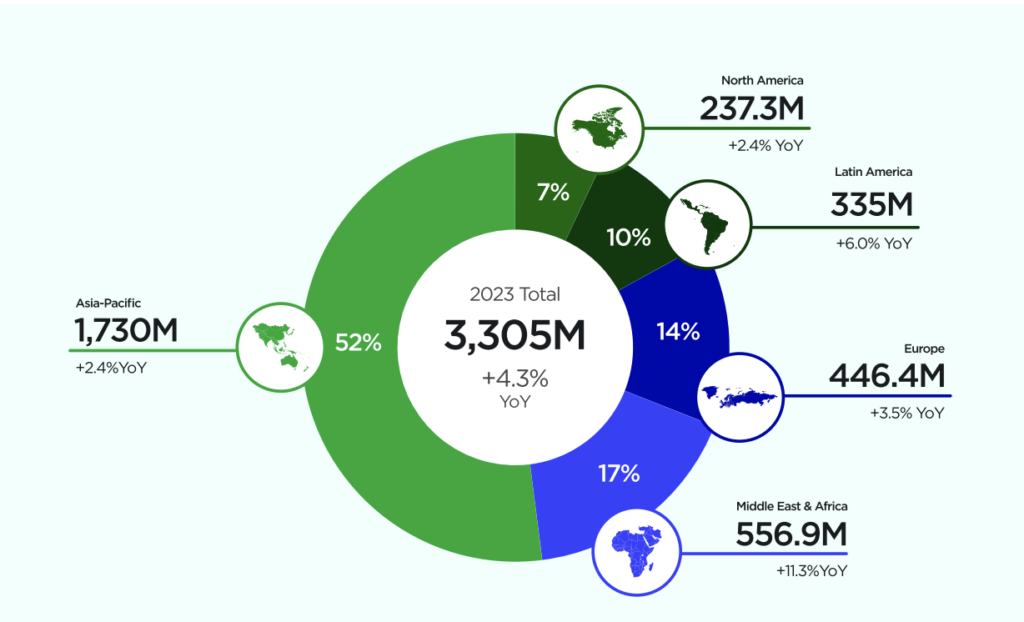
Source: resources.newzoo.com
Esports Financial Statistics
6. eSports Market Expected to Be Valued at $2.4 Billion in 2024
According to data published by Christina Gough, Statista’s team lead for the Sports & Recreation, Travel, Tourism & Hospitality research cluster, the global eSports market is anticipated to be valued at $2.4 billion in 2024.
7. Tencent Holdings Is the Leading eSports Company
In terms of market capitalization, Tencent Holdings is the largest eSports company across the world, as of December 2023. With a market capitalization of $472.33 billion, it’s also one of the top 20 biggest companies in the world.
It started as a PC-based messaging software in 1999 but has expanded its offering to games. Via its Tencent Games division, it has published top games like PlayerUnknown’s Battlegrounds Mobile (aka PUBG Mobile), rated as one of the biggest eSports games.
8. China Is the Highest Earning Country (by Prize Money)
In 2023, China was the highest-earning country. Chinese eSports players won $37.78 million from competitions that year.
The US was in second place with $28.71 million, while Russia was a distant third with “only” $14.47 million, basically half of what US players managed to accumulate.
9. The US Has the Biggest eSport Market in Terms of Revenue
In terms of revenue, though, the picture looks different with the United States taking the lead over China. In 2023, the US generated $871 million in revenue. China was in second position with $445.18 million.
10. Media Rights Segment Expected to Capture the Largest Market Share
Based on revenue streaming, the market can be divided into:
- Media rights
- Advertisement
- Sponsorship
- Ticket and merchandising
- Game publisher fees
Data shared by Fortune Business Insights reveal that the media rights segment is expected to hold the biggest share between 2024 and 2032. In 2023, it accounted for 23.8% of the eSports market share in the US.
Esports Growth Statistics
11. Global eSports Market Forecasted to Exceed $4.8 Billion by 2030
Like the actual games, the growth of the eSports market is also exciting to watch. After 2024, the market is set to continue its impressive growth.
It’s predicted that by 2030 the market’s value will exceed $4.8 billion. In 2023, it was merely $1.64 billion which means that in the span of seven years, it will nearly triple.
12. Japanese eSports Market Expected to Reach About 21.8 Billion Yen by 2025
As mentioned earlier, the majority of fans come from the APAC region. In Japan, eSports is also expected to grow.
In 2023, it was valued at ¥16.22 billion according to Statista Research Department’s stats. Using the same stats, it’s anticipated to reach nearly ¥20 billion in revenue by 2024. This works out to an increase of nearly 20%. Between 2024 and 2025 the growth will taper a bit, though, to reach ¥21.78 billion by 2025.
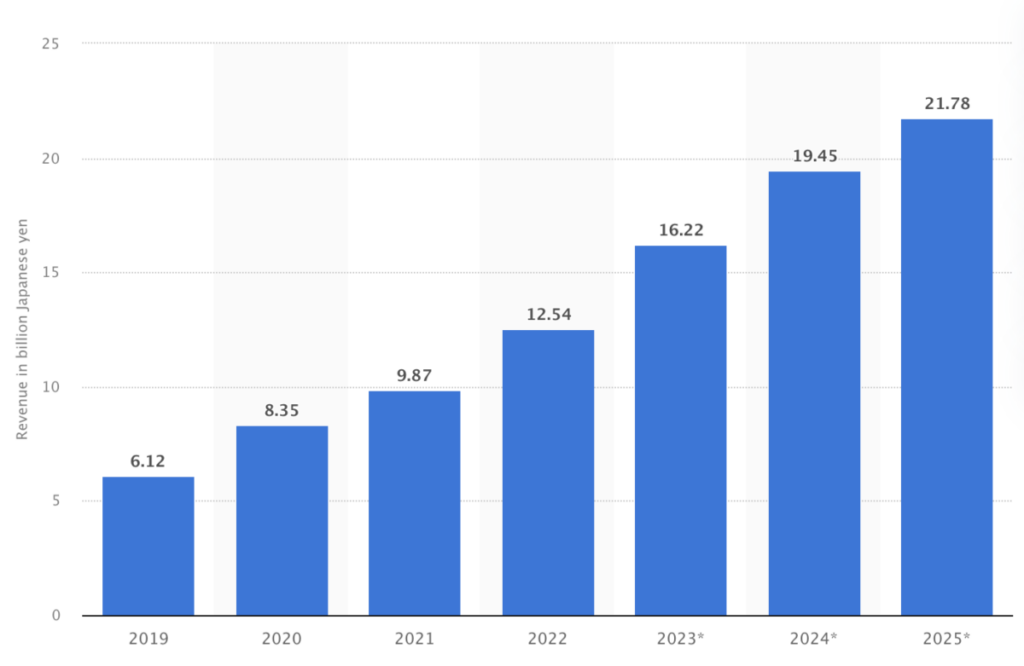
Source: statista.com
13. eSports Enthusiasts to Grow by ± 8%
Newzoo predicts that the compound annual growth rate (CAGR) for eSports enthusiasts from 2020 to 2025 will be approximately 8.0%. One of the main reasons there has been growth in eSports viewership is that more people are still learning about it. There has been a tremendous rise in awareness of the eSports industry since 2015.
So, what does this increase in viewership and awareness mean for brands? For the most part, it says that they have a new channel to target in their marketing mix.
14. Occasional Viewers Outnumber Enthusiasts (But Only Marginally)
It’s predicted that by 2025 there will be 322.7 million occasional viewers and 318.1 million eSports enthusiasts. What’s interesting to note is that the gap between those who watch only occasionally versus those who follow fanatically is expected to shrink significantly.
In 2021 and 2022 there were close to 10 million more occasional viewers. Based on these predictions, by 2025 there will be about only 4.6 million more.
Esports Tournament Stats
15. League of Legends 2023 World Championship Is the Most Watched Event of All Time
Attracting 6.4 million peak viewers, the League of Legends 2023 World Championship (aka LoL Worlds 2023) is the most-watched eSports event to date. The global tournament, which was held in South Korea in November 2023, saw team T1 being crowned as winners when they defeated Weibo Gaming.
Sports Illustrated explains that the reason why so many viewers tuned in to LoL Worlds 2023 was to see the 10-year-long rivalry between T1’s Lee “Faker” Sang-Hyeok and Kim “Deft” Hyuk-Ku. “Deft” beat “Faker” at the 2022 World Championship and viewers tuned in to see if Faker could redeem himself in 2023 and, at the same time, become the first person to win four World Championship titles.
After LoL Worlds 2023, the Free Fire World Series 2021 Singapore has attracted the most peak viewers. It boasted just over 5.4 million peak viewers.
16. Six Invitational eSports Tournament Doubles Its Peak Viewership in 2024
For Tom Clancy’s Rainbow Six Invitational eSports tournament, 2024 was a huge year. The yearly pro tournament is hosted by Rainbow Six’s publisher Ubisoft, which is also behind games like Assassin’s Creed.
The 2024 edition attracted over 521,000 peak viewers. Twenty teams competed for their share of the $3 million in prize money up for grabs. The final saw W7M Esports take on FaZe Clan with W7M Esports winning narrowly.

Source: ubisoft.com
While it’s not a patch on the millions of viewers that tuned in to watch LoL, it’s the most peak viewers the event has ever attracted. The inaugural event which took place in February 2017 attracted merely 72,250 peak viewers.
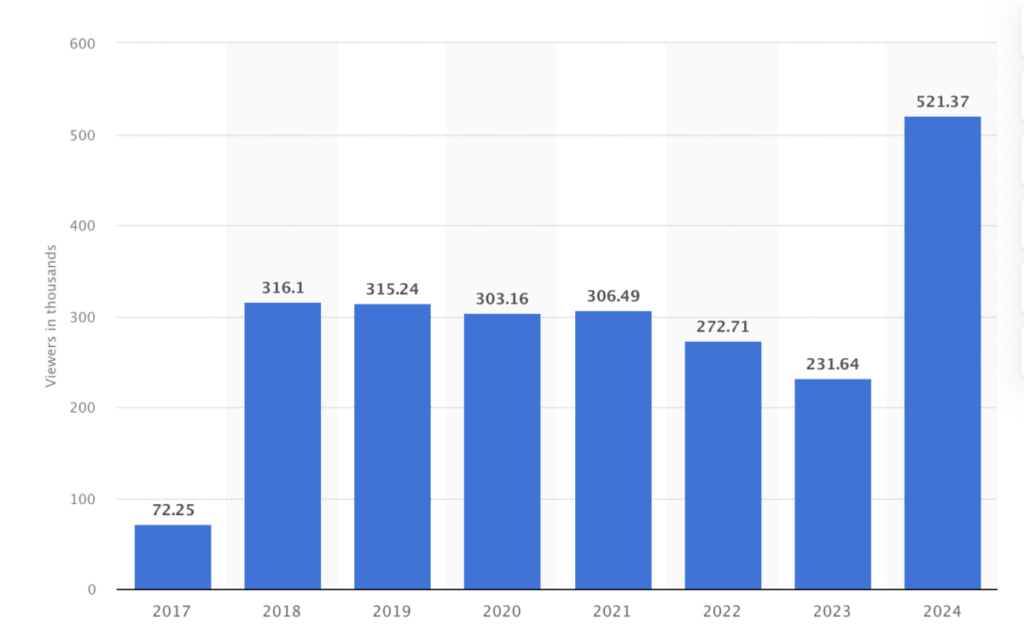
Source: statista.com
17. T1 (LoL) was the Most Watched eSports Team in 2023
While the League of Legends 2023 World Championship was T1’s most notable eSports event, the team also participated in several other tournaments that year. These included:
- LCK Spring 2023
- LCK Summer 2023
- MSI 2023
- Red Bull League of Its Own
All in all, more than 143 million hours of T1 content was watched in 2023, making them the most watched eSports organization that year.
The team is based in South Korea and has bagged nearly $10 million in prize money to date, according to Esports Charts.
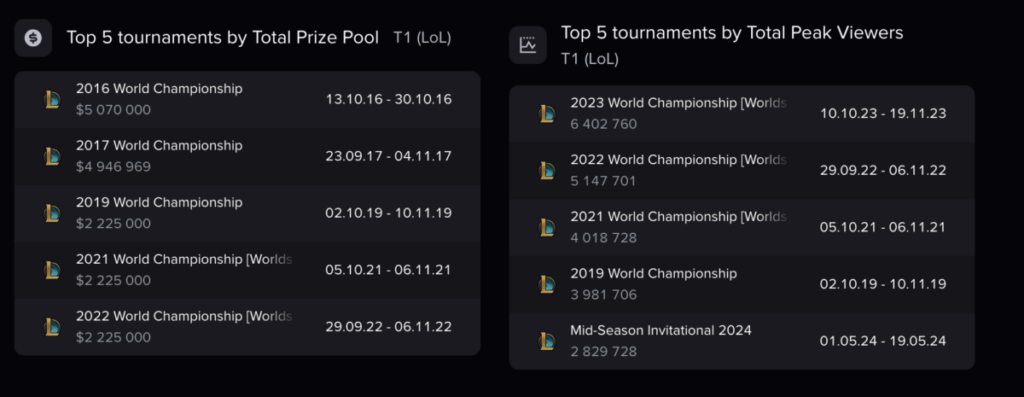
Source: escharts.com
18. The International 2021 Is the Leading Global Tournament (by Prize Pool Money)
“The International 2021” is the eSports tournament that has been the most lucrative to players financially to date. With a total prize pool of just over $40 million, no other tournament has offered a bigger prize pool yet.
Team Spirit, another one of the top eSports teams, was the team to walk away with these generous winnings.
After 2021, the prize pool for this tournament dropped significantly. In 2022, less than half was on offer, while Statista reports that 2023’s edition had a prize pool of only about $3.38 million.
The International (TI) tournament was initially organized as an event to market Dota 2’s release. It’s one of the major eSports tournaments to watch in 2024 when it returns for the 13th time.
Most of the prize pool is crowdfunded by selling battle passes to players. This pass (aka Compendium) offers extra content within the game that includes exclusive features and legendary rewards. Esports.net reports that we can expect 2024’s Battle Pass to be similar to 2023’s which will probably have a negative impact on sales, and, as such, the prize pool.
19. The Average Tournament Prize Pool Was $49,946 in 2023
Having millions of dollars at stake is the exception, though. Esports Earnings report that the mean tournament prize pool in 2023 was just shy of $50,000.
If you exclude high-paying tournaments like the Riyadh Masters that offered $15.12 million, the median tournament prize pool drops to only $3,840.68.
Esports Games Statistics
20. Dota 2 Boasted the Biggest Prize Pool in 2023
In 2023, Dota 2 was the top eSports game across the world in terms of cumulative tournament prize pool—and that by a long shot. Its prize pool was valued at $30.82 million.
PUBG Mobile was in second place with $21.22 million, followed by Fortnite with $19.72 million.
In terms of the number of players, though, Dota 2 lags behind. According to Esports Earnings, both PUBG Mobile and Fortnite attracted more players. PUBG Mobile had 1636 players, while Fortnite attracted 3280 players.
21. League of Legends Is the Most Popular Game on Twitch (By Peak Viewers)
When using peak all-time viewers as a metric, League of Legends is the most popular game on Twitch. The game generated 3.11 million peak viewers, as of June 2024.
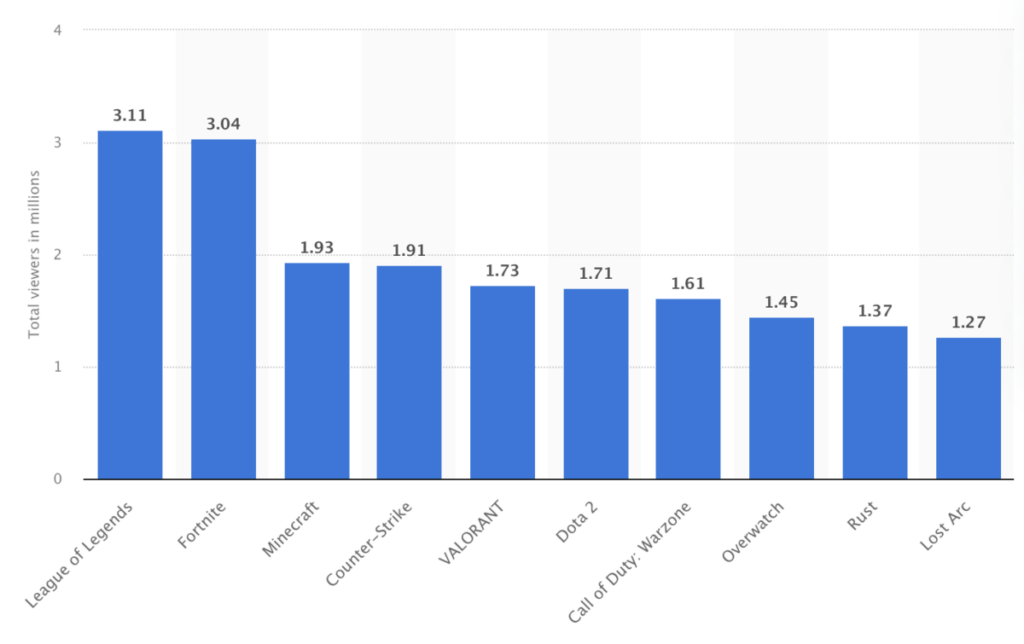
Source: statista.com
22. MOBA Games Is the Favorite Genre in China
A survey conducted among Chinese eSports fans in May 2023 revealed that multiplayer online battle arena games (aka MOBA games) is the most popular eSports game genre. The vast majority (75%) indicated that they mainly followed games in this genre.
Popular games in this genre include:
- League of Legends
- Dota 2
- Honor of Kings
Esports Player Statistics
23. Team Liquid Is the Leading Pro Team
In terms of the total prize money won, Team Liquid is regarded as the leading professional eSports team across the world. As of March 2024, they’ve raked in $48.58 million.
The team started as a StarCraft clan in 2000 in the Netherlands and mainly participates in Dota 2 tournaments. Some of their other notable achievements include:
- Growing their talent pool to over 160 gamers across more than 15 competitive game titles
- Winning over 75 premier events
- Ending in third place at The International 2022
24. N0tail Is the Leading eSports Player (by Overall Career Earnings)
As of February 2024, N0Tail (aka Johan Sundstein) is regarded as the leading eSports player across the world in terms of overall earnings. Thus far, he has earned more than $7 million during his gaming career.
Career earnings aside, he’s also reached other significant milestones like:
- Cofounding OG, a professional eSports organization
- Captaining the Dota 2 squad to an unlikely first place finish at The International 8
- Making the Forbes 30 Under 30 - Games list in 2019
25. Yatora Earned About $1.41 Million in 2023
Yatora (aka Ilya Mulyarchuk), a two-time TI champion, was 2023’s highest earning eSports player. He earned about $1.41 million for that period. While he has had a massive 2023, his total earnings is still about $2 million behind the highest earning player.
In July 2024, he changed his name to Raddan. Esports.net reports that it’s an interesting move considering the success he has achieved under Yatora.
26. Scarlett Is the Leading Female Player Across the Globe
As of February 2024, Scarlett (aka Sasha Hostyn) was the leading female eSports player across the globe in terms of her lifetime earnings as a professional gamer. Estimates place her earnings at about $459,000.

Source: escharts.com
This is only about 6% of what N0tail the leading (male) eSports player has generated over the span of his career. This huge discrepancy is evidence of the challenges that female eSports players face.
In July 2023, The New York Times reported that women face an alarming level of abuse that makes it challenging to start a full-time career in eSports. Not only do they need to deal with sexually violent threats, but also with the fact that teams sometimes allocate more resources to male players.
In fact, according to their article, “Inside the world of female esports: ‘It’s a scary space for women”, female players can get between $1,300 and $1,900 to start building their team while their male counterparts can receive about three times that amount. One player reports that male players will also likely get 85% of the coaching and time.
27. dupreeh the Leading CS:GO Player (by Overall Earnings)
Counter-Strike: Global Offensive (CS:GO) is rated as one of the top three most popular eSports games in terms of viewership. Over the past eight years, it offered an attractive tournament prize pool with the cumulative prize pools for competitions ranging between $15 million and $23 million per year.
As of June 2023, dupreeh (aka Peter Rasmussen) was the leading CS:GO eSports player across the globe in terms of overall earnings. He has managed to rake in $2.18 million by playing the online shooter game competitively.
28. The Average Earnings Per Player Was $7,399 in 2023
While these above-listed eSports player stats show that there’s a lot of earning potential, the reality is that for most it’s not the case.
According to Esports Earnings, a community-driven competitive gaming resource that uses freely available public information, the mean earnings per player in 2023 added up to only $7,399.53. However, this is worked out including the earnings of the high-earning gamers.

Considering that the highest earners make millions, you rather need to look at the median earnings per player to get a more accurate picture. Using this formula, these outliers, which will skew the results, are excluded.
According to their data, the median earnings per player in 2023 was less than $900. This significant difference between these two averages for player earnings clearly illustrate the huge pay gap between the best of the best and the average players.
Esports Platform and Streaming Statistics
29. eSports Live Streaming Viewership Down by 1%
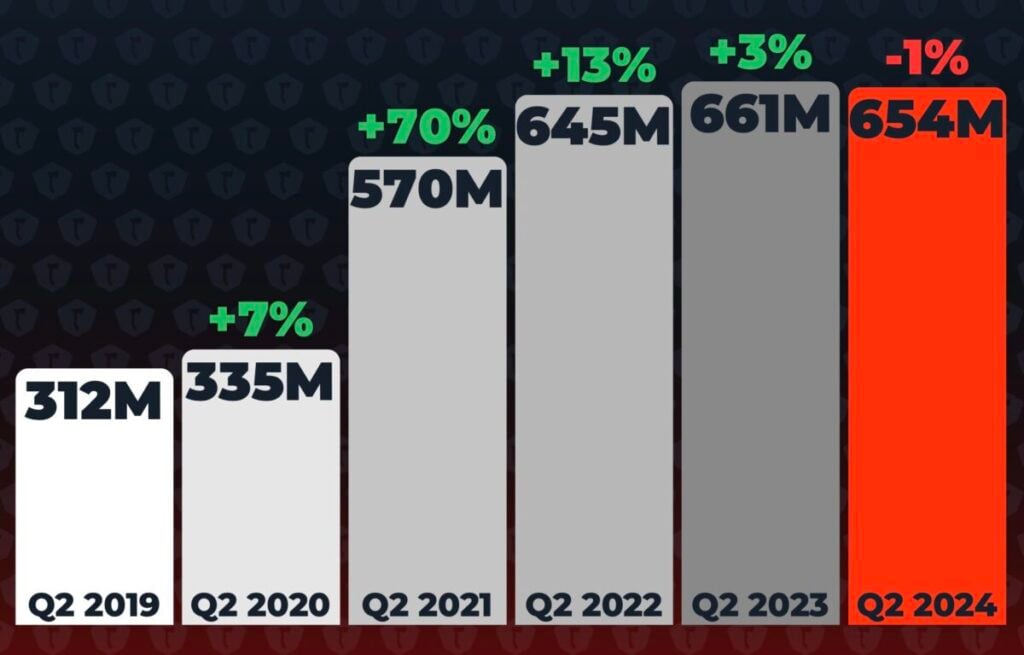
Source: hubspotusercontent-na1.net
Stream Hatchet’s Live Streaming Trends Report Q2 2024 found that viewership is nearly identical to the year before. Compared to Q2 2023, 7 million fewer hours of eSports were live streamed in Q2 2024.
While 7 million might sound like a lot, it’s a decrease of only 1%. Plus, considering that Q2 2023 boasted the most hours watched across all streaming platforms since 2019, it’s a hard number to beat.
So far, the League of Legends 2024 Mid-Season Invitational was the event that generated the most views. Nearly 70 million hours were spent watching it. MPL Indonesia Season 13 attracted 54 million views and the 2024 VALORANT Champions Tour: Americas League - Stage 1 generated 26 million, placing these events in second and third spots respectively.
30. Official Channels More Popular Than UGC

Official channels are still the most popular means to enjoy eSports. In 2023, two thirds of all the content was watched via an official channel. User-generated content (UGC) accounted for the rest of the viewership.
While UGC still lags behind, it’s up from 10% in 2020. This increase of 24% shows that publishers are becoming comfortable with creators co-streaming their tournaments.
Kyle Bautista, COO of Complexity Gaming, one of America’s premier eSports organizations, explains:
“The dynamic that was initially seen as threatening to media rights holders has evolved to create synergies between event hosts and individual content creators. Establishing guard rails to create mutually beneficial opportunities has provided fans with additional ways to consume compelling event content, allowing event stakeholders to further reach highly engaged fans.”
According to the 2024 Live-streaming, Esports & Social Trends Report presented by GameSquare and Stream Hatchet, 2023’s top co-streamers in terms of game viewership were:
- scump
- tarik
- Nix

31. League of Legends Is the Most Popular Gaming Category on Twitch
Twitch is basically synonymous with gaming. After its Just Chatting content category, most of the top content categories are all related to gaming.
League of Legends was the most popular gaming category in 2023. A staggering 1.23 billion hours of LoL content was watched across the globe from January to December 2023.
32. Ninja Has the Most Popular Channel on Twitch (in Terms of Followers)
Ninja (Richard Tyler Blevins in the offline world) is the most-followed Twitch streamer. As of June 2024, he had over 19 million followers.
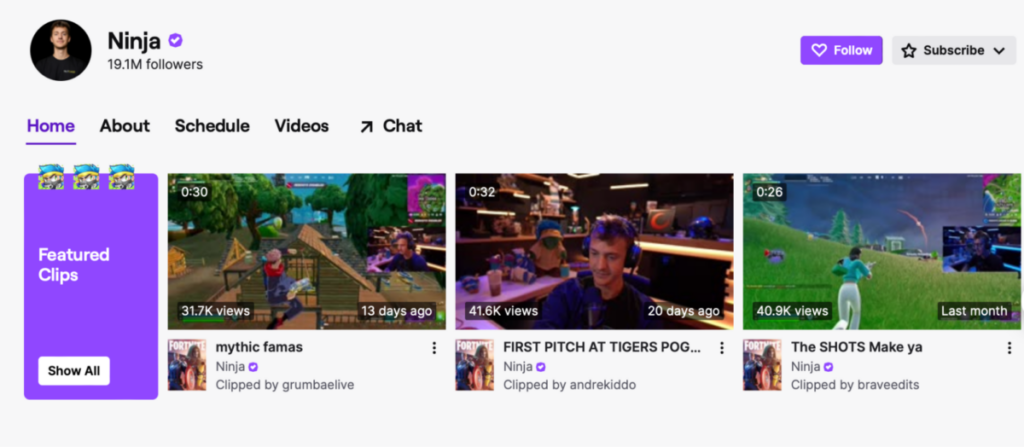
Source: twitch.tv
Jessica Clement, Statista’s research lead for internet and gaming, reports that as of April 2024 the platform had about 7.23 million active streamers, making his achievement that much more impressive.
His claim to Twitch fame is that he was one of the first top-ranked players to stream Fortnite Battle Royale when it was first released at the end of 2017. Fast-forward nearly seven years and Fortnite is still a top game. During May 2024, it was streamed on an average of 5,819 channels.
In second spot, it’s currently auronplay (Raúl Álvarez Genes in the offline world) with over 16 million followers.

Source: twitch.tv
33. 3.44 Million Is the Record for the Highest Number of Peak Concurrent Viewers on Twitch
While he might not have the most popular Twitch channel, ibai Llanos (aka Ibai Llanos) can boast the record for the most number of peak concurrent viewers. His livestream of his La Velada del Año 3 event in September 2023 generated 3.44 million peak concurrent viewers.
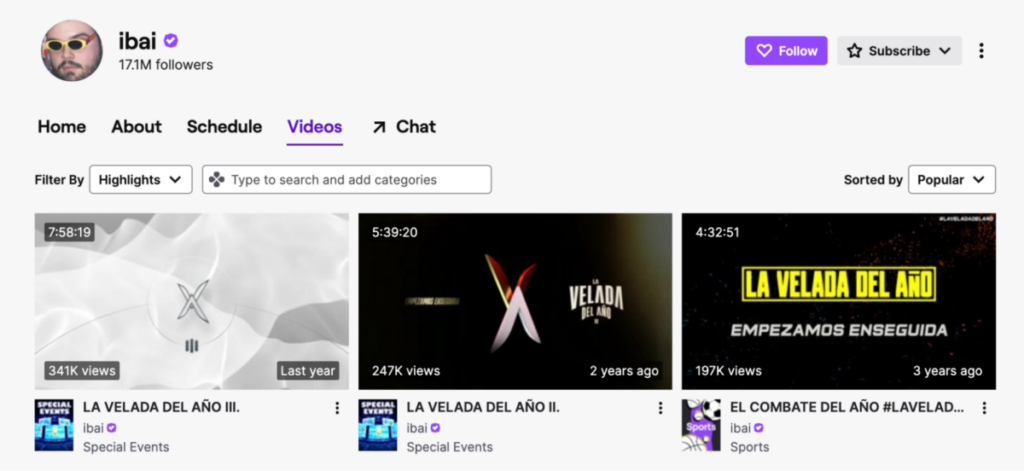
He’s also the only streamer who has attracted more than 3 million peak concurrent viewers. The streamer sitting in second spot is the Spanish YouTuber TheGrefg who has only managed to attract 2.39 million peak viewers for his top stream.
34. Global Gaming Livestreaming Audience Will Exceed 1.4 Billion by 2025
According to Newzoo’s data, it’s believed that by 2025 the global gaming livestreaming audience will reach 1.41 billion. This works out to a CAGR of 16.3% between 2020 and 2025.
Frequently Asked Questions
How do I become an eSports player and make money?
Here are some practical tips to help you become a successful eSports player:
- Focus on popular games like League of Legends, Dota 2, Fortnite and VALORANT
- Invest in a powerful PC/gaming console, stable and fast internet and a comfortable gaming chair (as you’ll be sitting here for hours)
- Study the game mechanics and strategies and get ready to practice, practice, practice
- Connect with other players on online forums like Discord
- Stream your gameplay on platforms like Twitch or YouTube
- Once you have a substantial following, see if you can monetize your stream
What are the main sources of income for eSports players?
eSports players can generate income via various sources that include:
- Winning competitions (a straightforward, but difficult, strategy)
- Donations
- Paid subscriptions
- Sponsorships
- Selling merch
How much do eSports players get paid by their teams?
eSports players can earn anything between $12,000 and about $190,000 per year. If you’re part of a well-sponsored team, you can earn even more.
How do sponsorships work in eSports?
Similarly to other professional athletes, eSports players can earn team endorsements and/or individual sponsorships. Brands will typically offer financial support to the player or team. In return, the brand will receive exposure.
How big of an industry is eSports?
The global eSports market will be valued at $2.4 billion in 2024, according to forecasts. It’s expected that in the span of six years it will double its value to exceed $4.8 billion.


